The document provides a comprehensive overview of GSM channel concepts and operations, detailing the frequency allocations for uplink and downlink channels as well as the structure of various logical channels used in GSM networks. It explains key concepts such as TDMA frame structure, control channels, SMS functionality, and subscriber identification through IMEI, MSISDN, and IMSI. The document also covers security mechanisms like SIM PIN management and TMSI for user confidentiality.
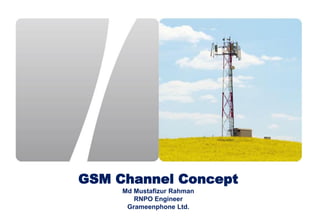
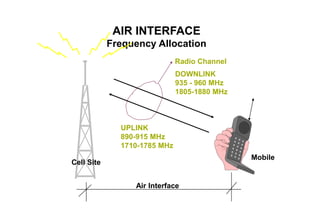

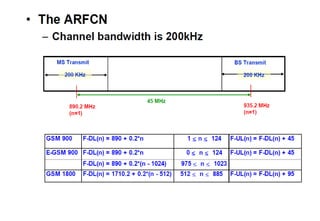












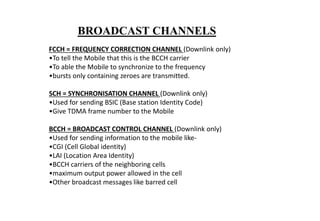
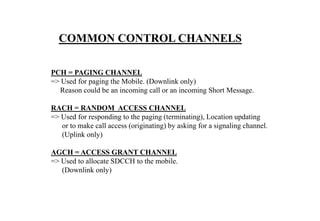
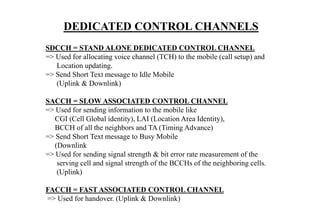

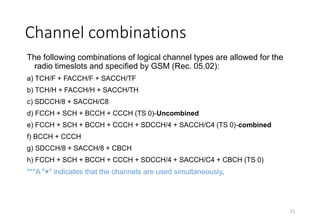




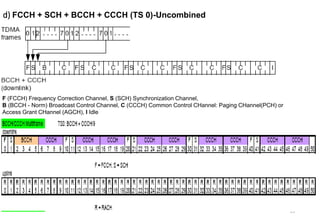
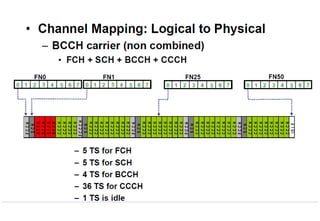
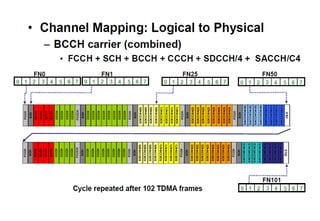

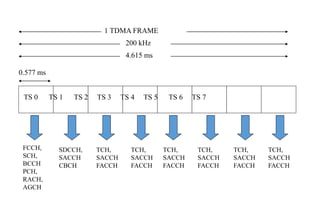

![MOBILE STATIONS ISDN NUMBER (MSISDN)
=> Is the mobile number used in a GSM PLMN (Public Land Mobile Network)
MSISDN = Country Code + National Destination Code + Subscriber number
e.x. 63 + 0918 + 8889999
Maximum length is 15 digits.
INTERNATIONAL MOBILE SUBSCRIBER IDENTITY (IMSI)
=> Is the subscriber number used over radio path for all signaling in the GSM PLMN.
This number is stored in SIM (Subscriber Identity Module), HLR (Home Location Register,
and VLR (Visitor Location Register).
IMSI = MCC + MNC + MSIN
= Mobile Country Code + Mobile Network Code + Mobile Identification Number
[ 3 digit ] [ 2 digit ] [ 11 digit ]
e.x. 502 + 19 + 2345451
TEMPORARY MOBILE SUBSCRIBER IDENTITY (TMSI)
=> Is used for the subscriber's confidentiality. Since the TMSI has only local significance
(within MSC/VLR) the structure of the TMSI can be chosen by the Vendor.
But the size must be 1/2 of the size of IMSI. Each time a mobile request for location
updating or call setup, MSC/VLR allocates to the IMSI a new TMSI, so the TMSI
is used on the signaling path, protecting the IMSI identity. Plus since the TMSI is half
the size of IMSI, we can page twice the amount compared to IMSI.](https://image.slidesharecdn.com/gsmchannelconcept-180609173507/85/GSM-Channel-Concept-32-320.jpg)
![LOCATION AREA IDENTITY (LAI)
=> Is used to uniquely identify each location area in the GSM PLMN. When the system
receives an incoming call it knows in which location area it should page the mobile
and does not page the entire network.
LAI = MCC + MNC + LAC
Mobile Country Code + Mobile Network Code + Location Area Code
[ 3 digit ] [ 2 digit ] [ 1 to 65 536 ]
e.x. = 502 + 20 + 60001
CELL GLOBAL IDENTITY (CGI)
=> Is used for cell identification within the GSM network.
LAI = MCC + MNC + LAC + CI
Mobile Country Code + Mobile Network Code + Location Area Code + Cell Identity
[ 3 digit ] [ 2 digit ] [ 1 to 65 536 ] [ 1 to 65 536 ]
e.x. = 502 + 20 + 60001 + 50001
BASE STATION IDENTITY CODE (BSIC)
=> Is used to distinguish co channel Frequency used in the neighboring cell.
BSIC = NCC + BCC
Network Color Code + Base Station Color Code
[ 1 to 7 ] [ 1 to 7 ]](https://image.slidesharecdn.com/gsmchannelconcept-180609173507/85/GSM-Channel-Concept-33-320.jpg)

